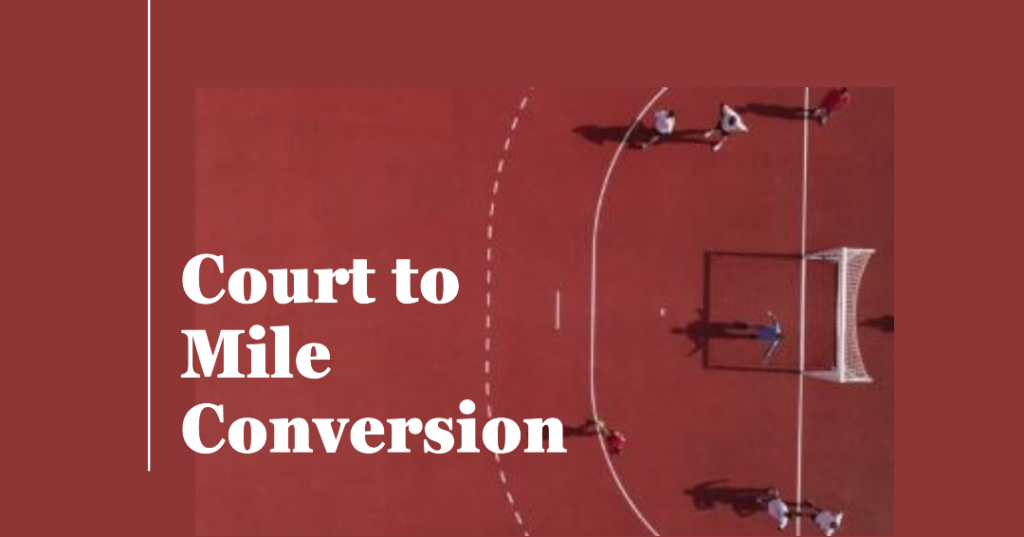It takes approximately five laps around a basketball court to complete a mile. Basketball courts have a standard length of 94 feet.
If you convert this to miles, it equals approximately 0. 0178 miles. You must run or walk around the basketball court 55 times to complete a mile. The number of laps can vary slightly depending on the size of the court or any additional markings on the court.
However, as a general estimate, five laps around the basketball court would equal a mile. This information is helpful for athletes, fitness enthusiasts, or individuals tracking their distance while exercising on a basketball court.
Understanding The Dimensions Of A Basketball Court
Understanding a basketball court’s dimensions is crucial to determining the number of laps needed to complete a mile. By calculating the perimeter and considering the standard length, one can determine that running around a basketball court four times constitutes a mile.
Basketball, a game loved by millions worldwide, is played on a court with specific measurements and dimensions. Whether you’re a basketball fan or player, understanding the standard measures of a basketball court and the size variations in different leagues can enhance your appreciation for this thrilling sport.
Let’s dive in and explore this exciting topic.
Explaining The Standard Measurements Of A Basketball Court:
- The standard basketball court dimensions for professional games, including the NBA and NCAA, are 94 feet in length and 50 feet in width.
- The court is divided into two halves, with a midcourt line separating them, and has several essential markings:
- Baseline: Lines at each end of the court that run parallel to the length.
- Sideline: Lines on the sides of the court that run similarly to the width.
- Key: An interior rectangular area, also known as the “paint” or “keyhole,” extends 19 feet from the baseline and is 16 feet wide.
- Three-Point Line: Arc-shaped lines determining the distance from which a successful shot is worth three points. In the NBA, the line is 23 feet 9 inches from the basket, while in the NCAA, it is 21 feet 7 7/8 inches.
- Free-Throw Line: A line located 15 feet from the center of the basket, from which players attempt their free-throw shots.
Discussing The Size Variations In Different Leagues:
- While the standard court dimensions are consistent across most professional leagues, there are some minor variations:
- FIBA (International Basketball Federation): FIBA courts are slightly smaller than NBA courts, measuring 91.86 feet long and 49.21 feet wide.
- High School: School basketball courts often have varying dimensions due to space constraints. However, the preferred dimensions are 84 feet in length and 50 feet in width, similar to NBA courts.
- Junior and Mini Basketball: Junior and mini basketball courts are scaled-down versions to suit the younger players. Depending on the age group, these courts can have dimensions ranging from 74 to 28 feet in length and 42 to 19.7 feet in width.
- Wheelchair Basketball: Wheelchair basketball courts have modified dimensions, with a minimum size of 78.74 feet in length and 42.65 feet in width, following specific guidelines for wheelchair maneuverability.
Understanding the dimensions of a basketball court is crucial for players, coaches, and fans alike. These standardized measurements provide consistency and fairness across different leagues and ensure a level playing field for all participants. So, next time you watch a basketball game or step foot on a court, take a moment to appreciate the precise dimensions that contribute to the excitement of the sport.
Calculating The Distance Of One Lap Around The Court
Wondering how many laps around the basketball court make a mile? By calculating the distance of one lap around the court, you can determine that it takes roughly four laps to complete a mile. So, get running and track your progress!
Breaking Down The Distance Covered During One Lap
Have you ever wondered how far you walk or run when you complete one lap around a basketball court? It may seem like a straightforward question, but a few factors must be considered. Let’s break down the distance covered during one lap around the court and explore some factors that can impact the distance covered.
- The standard size of a basketball court is 94 feet long and 50 feet wide. Specifically, for an NBA court, the dimensions are 94 feet long and 50 feet wide, while for an NCAA court, the sizes are slightly smaller at 94 feet long and 50 feet wide.
- When calculating the distance covered during one lap around the court, you need to consider the perimeter of the court. The edge of a rectangular shape is found by adding the lengths of all four sides. In this case, you would calculate the total size of both long and short sides.
- For an NBA court, the total length of the long sides would be 94 + 94 = 188 feet. Similarly, the entire length of the short sides would be 50 + 50 = 100 feet. Adding these two values together gives us a whole perimeter of 188 + 100 + 188 + 100 = 576 feet.
- Therefore, one lap around an NBA basketball court covers approximately 576 feet.
- The calculation for an NCAA court is the same but with slightly smaller dimensions. The total perimeter for an NCAA court would be calculated as 180 + 90 + 180 + 90 = 540 feet, making one lap around an NCAA basketball court approximately 540 feet.
Factors That Can Impact The Actual Distance Covered
While the distances mentioned above give a general idea of how far you would walk or run during one lap around a basketball court, a few factors can impact the actual distance covered. These factors include:
- The type of game being played: During different kinds of basketball games, such as full-court versus half-court, the distance covered during one lap around the court may vary. Full-court games covering the entire court will protect the calculated distances mentioned earlier. However, in half-court games, only -half of the court is used, which means the distance covered will also be halved.
- Player movement: The movement of players during a game can impact the distance covered. Frequent changes in direction, sprints, and jumps can increase the overall length covered during one lap.
- Player position: Depending on the player’s work on the court, the distance covered may vary. Guards and forwards tend to move more frequently and cover greater distances than centers that typically stay closer to the basket.
- Playing style and strategy: Different playing styles and techniques adopted by teams can also affect the distance covered. Fast-paced, high-energy playing styles may result in players covering more space than slower, deliberate strategies.
Keep in mind that the distances mentioned here are approximate and can vary depending on the specific measurements and factors discussed above. So, the next time you wonder about the space you cover during one lap around a basketball court, consider these factors and remember that every step counts towards achieving your fitness goals.
Determining The Number Of Laps In A Mile
The number of laps in a mile around a basketball court can be determined by considering the court’s dimensions and calculating the distance covered for each lap. By measuring the length of the court and dividing it by the mile size, you can determine how many laps you need to complete to cover a mile’s distance.
Method 1: Measuring The Exact Distance Of A Mile On The Court
If you’re looking to determine the number of laps around a basketball court that make up a mile, you can use a few methods. One way involves measuring the exact distance of a mile on the court. Here’s how you can do it:
- Start by measuring the baseline of the court using a measuring tape.
- Multiply the baseline measurement by 2 to account for both sides of the court.
- Measure the distance between the free-throw lines, typically 15 feet in amateur basketball.
- Multiply the free-throw line measurement by 2 to account for both sides of the court.
- Add the baseline and free-throw line measurements to get the total distance of one lap around the court in feet.
- Divide the length of one lap by 5,280 (the number of feet in a mile) to determine the number of laps in a mile.
Method 2: Using The Average Distance Covered Per Lap
Another way to determine the number of laps in a mile is by using the average distance covered per lap. Here’s how you can calculate it:
- Measure the distance between the baseline and the mid-court line.
- Multiply the baseline to mid-court line measurement by 2 to account for both sides of the court.
- Measure the distance between the baseline and the three-point line.
- Multiply the baseline to three-point line measurement by 2 to account for both sides of the court.
- Add the baseline to the mid-court line measurement and the baseline to the three-point line measurement to cover the total distance in one lap around the court.
- Divide the total distance covered in one lap by the total distance covered in a mile to determine the number of laps in a mile.
Method 3: Considering The Court Dimensions And Converting To Miles
Alternatively, you can determine the number of laps in a mile by considering the court dimensions and converting them to miles. Here’s how you can do it:
- Measure the length and width of the court in feet.
- Convert the length and width measurements to miles by dividing them by 5,280 (the number of feet in a mile).
- Multiply the length and width measurements in miles to get the total area of the court in square miles.
- Divide the full size of the court by the area covered by one lap (assuming a rectangular lap) to determine the number of laps in a mile.
By following any of these methods, you’ll find out exactly how many laps around the basketball court make up a mile. So grab your sneakers, get on the court, and start tracking your mile in style!
Factors That Affect The Number Of Laps
The number of laps around a basketball court that equals a mile can vary depending on factors such as stride length, court dimensions, and individual fitness levels. These factors contribute to the overall distance covered while running multiple laps on the court.
Are you wondering how many laps around the basketball court make up a mile? The distance covered can vary depending on several factors. In this section, we will discuss the influence of stride length on lap distance, how speed affects the number of laps, and how to adjust for different fitness or skill levels.
Influence Of Stride Length On Lap Distance
- Longer strides cover more distance: Athletes with longer strides will complete a lap with fewer steps, covering more ground.
- Shorter strides require more laps: Individuals with shorter strides will need more steps to complete a lap, resulting in more laps to cover a mile.
How Speed Affects The Number Of Laps
- Faster speed reduces lap count: If you’re sprinting around the court, your rate will allow you to cover more distance in less time, reducing the number of laps needed to complete a mile.
- Slower speed increases lap count: Conversely, moving at a slower pace will take more laps to cover a mile.
Adjusting For Different Fitness Or Skill Levels
- Beginners may need more laps: If you’re new to basketball or have lower fitness levels, you might need to gradually increase the number of laps to build stamina and endurance.
- Advanced players may require fewer laps: Experienced players with higher fitness levels may need fewer laps to achieve the mile distance due to greater efficiency and physical conditioning.
Remember, these factors will vary from person to person, and focusing on your abilities and goals is essential. Now that you understand how stride length, speed, and fitness level can affect the number of laps around the basketball court, you can tailor your workouts accordingly.
So grab your basketball, and start measuring those laps towards your mile milestone!
Comparing Basketball Court Laps To Other Activities
Compared to other activities, basketball court laps show that it takes approximately 20 laps to complete a mile. This endurance exercise provides a great cardiovascular workout and helps burn calories effectively.
How Many Laps Around The Basketball Court Is A Mile:
If you’re an avid basketball player or enjoy shooting hoops, you may have wondered how many laps around the basketball court would equal a mile of running. While basketball is primarily a game of quick sprints and jumping, calculating the distance covered by multiple laps can provide an interesting perspective.
This section will compare the laps it takes to complete a mile on a basketball court with various other sports and activities.
Conversion To Other Sports And Activities:
When comparing basketball court laps to other sports and activities, the distance covered depends on the size and dimensions of the court or playing area. Below, we’ll illustrate the equivalent distances covered for different sports and activities:
- Soccer (Football) Field:
- A full-size soccer (football) field is approximately 1.32 acres or 57,600 square feet.
- Running lengthwise from one goal line to another is roughly equivalent to 54 laps around a basketball court.
- Tennis Court:
- A standard tennis court measures 78 feet in length and 36 feet in width.
- One lap around a tennis court is approximately equivalent to 2.2 laps around a basketball court.
- Track and Field:
- A standard outdoor running way is 400 meters in length.
- Running four laps around a standard track equals running approximately one mile, equivalent to six laps around a basketball court.
- Swimming Pool:
- A standard pool length in competitive swimming can be 25 or 50 meters, depending on the event.
- Swimming 64 lengths of a 25-meter pool is roughly equivalent to completing a mile, approximately 256 laps around a basketball court.
- Cycling:
- The distance covered during a cycling race or training ride varies depending on the route and terrain.
- On average, cycling approximately 3.75 miles is equivalent to running one mile or completing 18 laps around a basketball court.
Remember that these equivalencies are approximate and can vary based on each sport or activity’s specific dimensions and requirements. However, they provide a helpful comparison of the distance covered when running laps around a basketball court about other popular sports and activities.
Tips For Tracking Laps And Mileage
If you’re wondering how many laps around the basketball court equals a mile, here are some tips for tracking your laps and mileage. Keep track of each lap and measure the distance accurately to determine the number of laps needed to complete a mile.
When it comes to tracking your laps and mileage while running or walking on a basketball court, there are several techniques you can utilize to ensure accuracy. Whether you prefer using fitness trackers or smartphone apps, these tools can assist you in keeping track of your progress.
Below are some tips for tracking laps and mileage effectively:
Utilizing Fitness Trackers And Apps:
- Fitness trackers: These wearable devices provide real-time data, including distance covered, number of laps, and calories burned. Consider investing in a fitness tracker that accurately measures your movements and offers reliable information.
- Smartphone apps: Numerous fitness apps are available that utilize your smartphone’s GPS function to track your distance and laps. Some popular apps include Nike Run Club, Strava, and MapMyRun. These apps provide comprehensive records of your activities, allowing you to analyze your performance over time.
Techniques For Counting Laps Accurately:
- Pedometers: Attach a pedometer to your clothing or shoe, as it can count steps and estimate the distance covered during your laps on the basketball court.
- Lap counting clickers: These small handheld devices are specifically designed for counting laps. With each lap completed, press the button on the clicker to keep an accurate tally.
- Visual markers: If you prefer a more manual approach, consider placing visible features on the side of the basketball court to help keep track of your laps. You can use cones, chalk marks, or small flags to mark each completed lap.
- Mental counting: For those who enjoy a mental challenge, you can count your laps mentally as you run or walk. However, staying focused and avoiding distractions is essential to ensure an accurate count.
- Partner with accountability: Running or walking with a partner adds motivation and provides an additional way to count laps accurately. You and your partner can take turns keeping track of the laps, minimizing the chance of miscounting.
Remember, choosing a tracking method that suits your preferences and helps you stay motivated throughout your workout is essential. You can confidently determine the number of laps around the basketball court that make up your desired distance by utilizing fitness trackers, smartphone apps, or various counting techniques.
So, lace up your shoes and accurately track your laps and mileage!
Benefits Of Running On A Basketball Court
Running on a basketball court offers numerous benefits, including improved cardiovascular endurance and agility. Wondering how many laps around the court make up a mile? Keep reading to find out.
Running on a basketball court offers several advantages for individuals looking to improve their endurance and agility. The unique nature of the court, its surface, and the movements involved in basketball contribute to these benefits. Here are the benefits discussed in detail:
Enhances Endurance
- Running on a basketball court allows you to maximize your endurance levels.
- The constant back-and-forth movements involved in basketball require sustained effort, thus building your cardiovascular stamina.
- The engaging nature of the sport keeps you motivated, helping to improve your overall endurance capacity.
Improves Agility
- Running on a basketball court can significantly enhance your agility, allowing you to change directions and move quickly and easily.
- The quick lateral movements, pivots, and cuts in basketball help develop agility and quick reflexes.
- Regular running on the court strengthens the muscles responsible for these movements, boosting your overall agility levels.
Works for Multiple Muscle Groups
- Running on a basketball court engages various muscle groups throughout your body.
- As you sprint, jump, and change directions, your legs, including the calves, thighs, and glutes, become actively involved and stronger.
- Additionally, your core muscles, including the abs and lower back, maintain balance and stability while running on the court.
- The upper body muscles, such as the shoulders and arms, also support your movements and enhance overall coordination.
Builds Mental Toughness
- Running on a basketball court challenges both your physical and mental abilities.
- The fast-paced nature of the sport requires you to make split-second decisions, improve your reflexes, and respond to the changing game dynamics.
- This mental aspect of running on a basketball court helps build resilience, concentration, and decision-making skills, which can benefit you in various parts of life.
Provides A Fun And Motivating Environment
- Running on a basketball court offers a fun and dynamic environment to help you stay motivated and engaged in your workout routine.
- The competitive nature of basketball can drive you to push harder and achieve better results.
- Playing basketball or running on the court with friends can also add a social element, making it enjoyable while staying physically active.
Running on a basketball court can be an excellent way to improve endurance, agility, and overall fitness. The sport’s unique movements and engaging nature provide numerous benefits beyond physical fitness. Incorporating running on a basketball court into your workout routine can help you achieve your fitness goals while enjoying a fun and challenging activity.
Considerations For Running Longer Distances On A Court
Running longer distances on a basketball court requires multiple laps, but how many laps equal a mile? On a standard court, you need to complete around eight laps to cover the distance of one mile.
Running on a basketball court can be a great way to improve your fitness and endurance. While shorter sprints and drills are standard on the court, you may wonder about running longer distances. This section will explore the limitations of running extended stretches on a basketball court and provide strategies for adding variety to your longer runs.
Exploring The Limitations Of Running Extended Distances
Running extended distances on a small basketball court can present some challenges. Here are a few considerations to keep in mind:
- Limited space: Unlike running on a track or outdoors, the area on a basketball court is significantly smaller. This little space can make it harder to cover longer distances without repeating laps.
- Monotony: Continuous laps around a basketball court can become monotonous and mentally draining. Keeping motivation levels high can struggle when the scenery doesn’t change much.
- Impact on joints: The repetitive motions of running on a hard surface can put extra strain on your joints, particularly if you’re running longer distances. Proper footwear and maintaining good form are essential to minimize the risk of injury.
- Lack of outdoor elements: Running on a court means missing out on the natural ingredients that can make long-distance runs more enjoyable, such as fresh air and varied terrain.
Strategies For Adding Variety To Longer Runs
To make your longer runs on a basketball court more exciting and challenging, try incorporating these strategies:
- Interval training: Alternate between faster and slower-paced laps or incorporate timed intervals to mix up the intensity of your run.
- Change directions: Vary your running to engage different muscles and prevent overuse injuries. Running clockwise for a few laps and switching to counterclockwise can provide a welcome change.
- Incorporate exercises: To break up the monotony, add bodyweight exercises like lunges, squats, or push-ups between laps. This not only diversifies your workout but also helps build strength and endurance.
- Music or audiobooks: Create a motivating playlist or listen to audiobooks while running to distract your mind from the repetitive nature of laps. Music and engaging stories can help make the time go by faster.
- Run with a partner: If possible, find a running buddy to join you on the court. The company makes the run more enjoyable and adds accountability and motivation to go the distance.
With these considerations and strategies in mind, running longer distances on a basketball court can be a challenging and fulfilling workout. Adapting and implementing these ideas can help you maximize the benefits of your extended runs while minimizing the limitations imposed by the court’s small space.
So, lace up your running shoes, grab some water, and get ready to tackle those laps with renewed enthusiasm.
Frequently Asked Questions Of How Many Laps Around The Basketball Court Is A Mile
How Many Laps Are In A Mile?
There are four laps in a mile on a standard 400-meter track.
How Do You Run A Mile On A Basketball Court?
To run a mile on a basketball court, start at one end and run to the other for four laps.
How Many Laps Around A Tennis Court Is A Mile?
It takes approximately four laps around a tennis court to cover a mile.
How Long Is The Perimeter Of A Basketball Court?
The perimeter of a basketball court is 84 feet long.
Conclusion
Determining the number of laps around a basketball court in a mile depends on factors such as the court size, type of laps, and individual stride length. However, on an average-sized court, completing one mile typically takes 12-13 laps.
Whether you’re a basketball player looking to track your distance or a runner using the court as your training ground, keeping this estimation in mind can help set goals and measure progress. Listening to your body and adapting your workout routine is always essential.
So, lace up those shoes and get ready to make the most of your time on the basketball court as you strive to achieve your fitness goals. Keep moving, stay motivated, and enjoy the journey to a healthier and fitter you.






